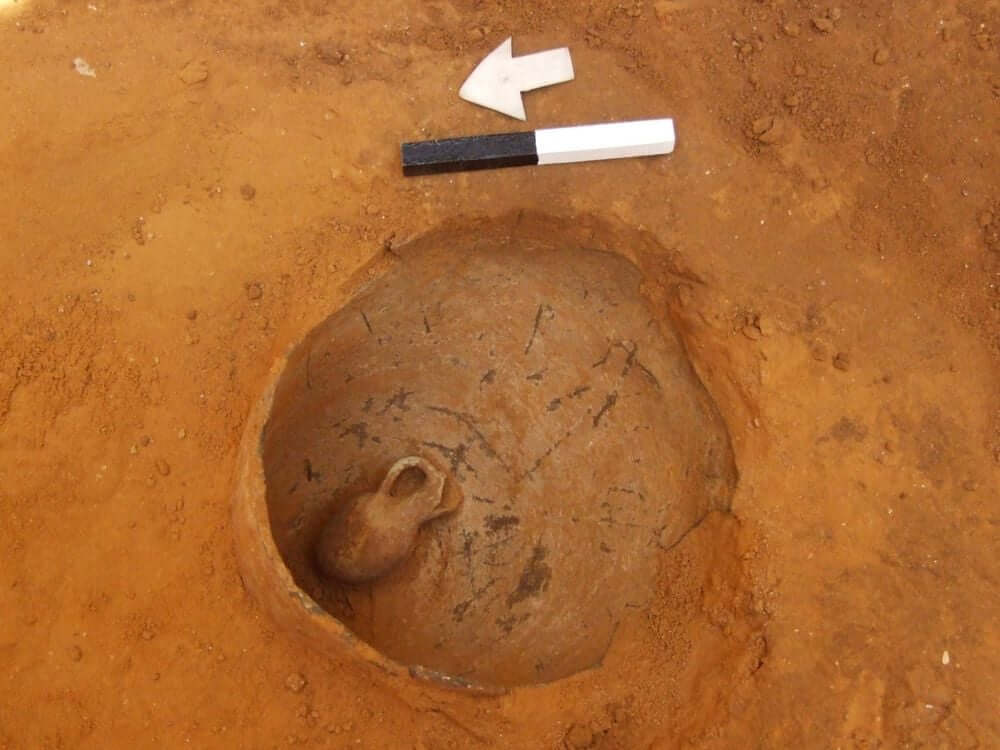By: Isis Davis-Marks | Smithsonian
Archaeologists excavating a site in Jaffa, Israel, recently made a macabre discovery: a 3,800-year-old jar containing the skeleton of a baby.
As Ariel David reports for Haaretz, researchers from the Israel Antiquities Authority (IAA) uncovered the poorly preserved remains, which were buried in a shallow pit about ten feet below street level, while surveying the ruins of the 4,000-year-old city ahead of construction.
The practice of burying babies in jars dates back to the Bronze Age and continued until as recently as the 20th century, IAA archaeologist Yoav Arbel tells Live Science’s Laura Geggel. But while evidence of such funerary rituals regularly appears in the archaeological record, scholars remain unsure of the practice’s purpose.
“You might go to the practical thing and say that the bodies were so fragile, [maybe] they felt the need to protect it from the environment, even though it is dead,” says Arbel. “But there’s always the interpretation that the jar is almost like a womb, so basically the idea is to return [the] baby back into Mother Earth, or into the symbolic protection of his mother.”
Speaking with Ashley Cowie of Ancient Origins, archaeologist Alfredo Mederos Martin, who was not involved in the IAA research, notes that people across the ancient world entombed children in jars as early as 4,500 B.C. Methods varied from place to place, with civilizations adapting the process to reflect their unique conceptions of death.
In a 2019 article published in the Biblical Archaeology Review, scholar Beth Alpert Nakhai suggested that the jars’ burial beneath the home signified “a desire on the part of [the] dead infant’s mother to care for her child in death, as she would have cared for that child in life.” These kinds of burials could also reflect a change in ancient societies’ attitude toward the young; previously, prehistoric humans had only buried adults in jars, “indicating that children were [thought] to be of little importance,” as Ruth Schuster pointed out for Haaretz in 2018.
Over the past decade, officials have conducted digs at five locations across Jaffa. They detailed their impressive array of discoveries in the IAA’s journal, Atiqot, last month.
Highlights of the finds include 30 Hellenistic coins; the remains of at least two horses and pottery dated to the late Ottoman Empire; 95 glass vessel fragments from the Roman and Crusader periods; 14 fifth-century B.C. rock-carved burials featuring lamps, juglets and other funerary offerings; and the strangely interred infant.
Jaffa has a storied history that spans some four millennia. One of the world’s earliest port cities, the ancient settlement is now part of Tel Aviv, Israel’s second-most populated metropolis.
According to Haaretz, Jaffa experienced at least three periods of major expansion. The first took place in Hellenistic times, while the second stretched across the Byzantine, Islamic and Crusader eras.
Israeli Archaeologists Unveil Hellenistic Fortress Destroyed By Jewish Forces In 112 B.C.E.
Finally, Arbel tells Haaretz, “[f]rom the mid-19th century to the end of the Ottoman era there was huge population growth. Jaffa grew exponentially and became a cosmopolitan city.”
The researcher adds that experts hadn’t realized the full extent of the city’s archaeological wealth until recently.
“There were those who told us there was no point to excavate around the mound,” or central stretch of high ground on which Jaffa is situated, he says.
But subsequent archaeological work revealed that Jaffa, like many other ancient cities, expanded into the surrounding lowlands during periods of prosperity and tightened up its boundaries in times of strife.
Though researchers covered up many of the archaeological sites after recording their overlooked histories, several—from Crusader-era walls preserved in a hospital-turned-hotel to the ruins of an Ottoman-era soap factory—remain accessible to the public.
* * *
NEXT UP!
Gobekli Tepe: The World’s First Temple?
Six miles from Urfa, an ancient city in south-eastern Turkey, Klaus Schmidt has made one of the most startling archaeological discoveries of our time: massive carved stones about 11,000 years old, crafted and arranged by prehistoric people who had not yet developed metal tools or even pottery. The megaliths predate Stonehenge by some 6,000 years.
The place is called Gobekli Tepe, and Schmidt, a German archaeologist who has been working here more than a decade, is convinced it’s the site of the world’s oldest temple.
* * *
READ MORE: This Ancient Maya City Was Hidden In The Jungle For More Than 1,000 Years
More Archaeology News: Guanches: Ancient Mummies of The Canary Islands (Video)
Enjoyed it? Please take a moment to show your support for Collective Spark.
We’d love to hear from you! If you have a comment about this article or if you have a tip for a future Collective Spark Story please let us know below in the comment section.

